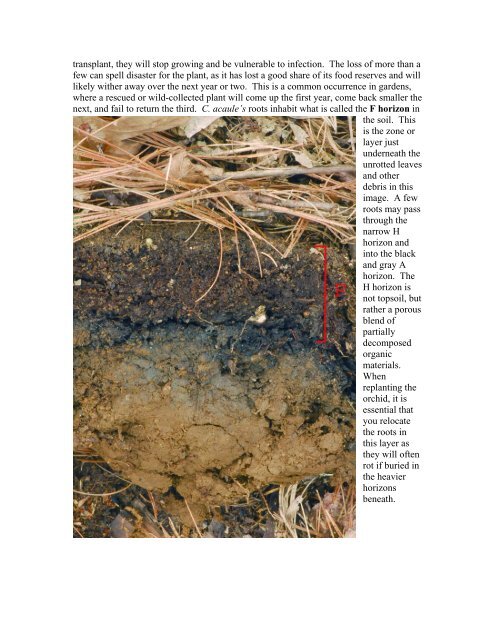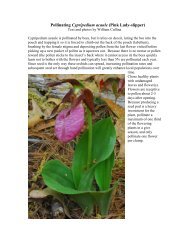Transplanting Pink lady-slipper (Cypripedium acaule) - William Cullina
Transplanting Pink lady-slipper (Cypripedium acaule) - William Cullina
Transplanting Pink lady-slipper (Cypripedium acaule) - William Cullina
You also want an ePaper? Increase the reach of your titles
YUMPU automatically turns print PDFs into web optimized ePapers that Google loves.
transplant, they will stop growing and be vulnerable to infection. The loss of more than a<br />
few can spell disaster for the plant, as it has lost a good share of its food reserves and will<br />
likely wither away over the next year or two. This is a common occurrence in gardens,<br />
where a rescued or wild-collected plant will come up the first year, come back smaller the<br />
next, and fail to return the third. C. <strong>acaule</strong>’s roots inhabit what is called the F horizon in<br />
the soil. This<br />
is the zone or<br />
layer just<br />
underneath the<br />
unrotted leaves<br />
and other<br />
debris in this<br />
image. A few<br />
roots may pass<br />
through the<br />
narrow H<br />
horizon and<br />
into the black<br />
and gray A<br />
horizon. The<br />
H horizon is<br />
not topsoil, but<br />
rather a porous<br />
blend of<br />
partially<br />
decomposed<br />
organic<br />
materials.<br />
When<br />
replanting the<br />
orchid, it is<br />
essential that<br />
you relocate<br />
the roots in<br />
this layer as<br />
they will<br />
often<br />
rot if buried in<br />
the heavier<br />
horizons<br />
beneath.




